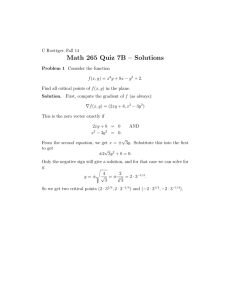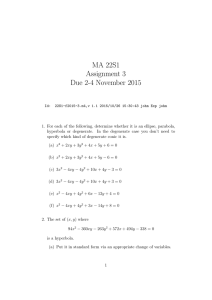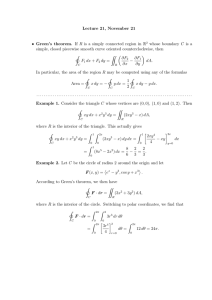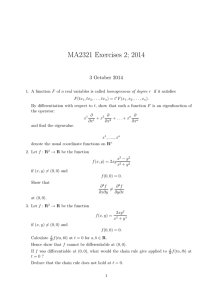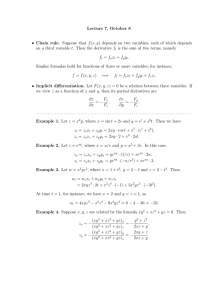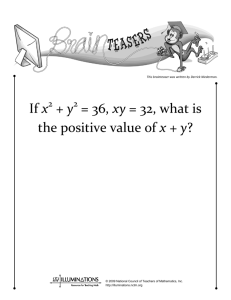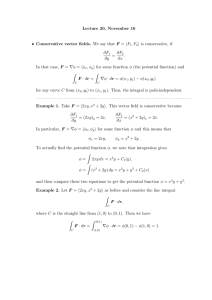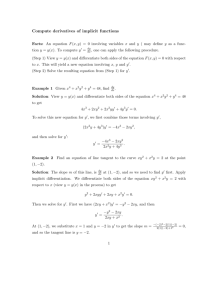So far, the majority of the material discussed in class... type of problem: Given an equation of the form
advertisement
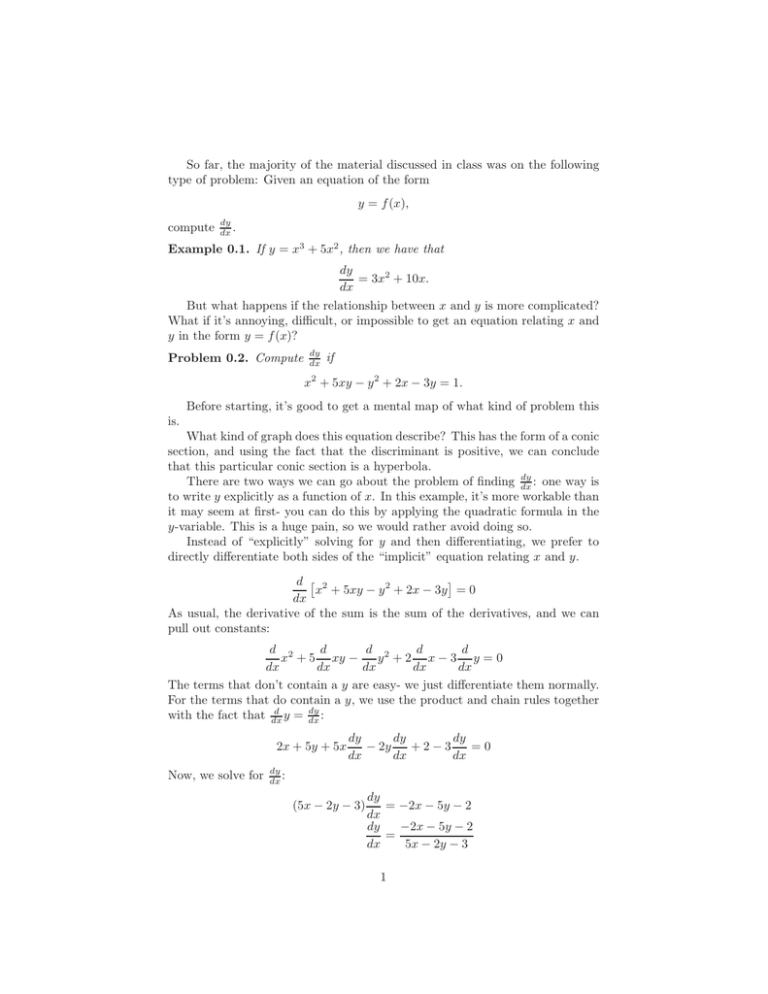
So far, the majority of the material discussed in class was on the following type of problem: Given an equation of the form y = f (x), compute dy dx . Example 0.1. If y = x3 + 5x2 , then we have that dy = 3x2 + 10x. dx But what happens if the relationship between x and y is more complicated? What if it’s annoying, difficult, or impossible to get an equation relating x and y in the form y = f (x)? Problem 0.2. Compute dy dx if x2 + 5xy − y 2 + 2x − 3y = 1. Before starting, it’s good to get a mental map of what kind of problem this is. What kind of graph does this equation describe? This has the form of a conic section, and using the fact that the discriminant is positive, we can conclude that this particular conic section is a hyperbola. dy There are two ways we can go about the problem of finding dx : one way is to write y explicitly as a function of x. In this example, it’s more workable than it may seem at first- you can do this by applying the quadratic formula in the y-variable. This is a huge pain, so we would rather avoid doing so. Instead of “explicitly” solving for y and then differentiating, we prefer to directly differentiate both sides of the “implicit” equation relating x and y. d 2 x + 5xy − y 2 + 2x − 3y = 0 dx As usual, the derivative of the sum is the sum of the derivatives, and we can pull out constants: d 2 d d 2 d d x + 5 xy − y +2 x−3 y =0 dx dx dx dx dx The terms that don’t contain a y are easy- we just differentiate them normally. For the terms that do contain a y, we use the product and chain rules together dy d with the fact that dx y = dx : 2x + 5y + 5x Now, we solve for dy dy dy − 2y +2−3 =0 dx dx dx dy dx : (5x − 2y − 3) dy = −2x − 5y − 2 dx dy −2x − 5y − 2 = dx 5x − 2y − 3 1 The downside to this kind of answer is that it depends on both x and y- we call this type of equation a non-autonomous differential equation. However, in practice, this is often not a problem. For example, let’s consider the following problem: Problem 0.3. Find the tangent lines to the graph of x2 + 5xy − y 2 + 2x − 3y = 1. at the points for which x = 1. Looking at the graph of the hyperbola in the geogebra example file, it’s clear that there are two points on the hyperbola for which x = 1. We can find both of these points using algebra: substituting x = 1 into the above equation gives 1 + 5y − y 2 + 2 − 3y = 1 which simplifies to −y 2 + 2y + 2 = 0 I like to keep the leading coefficient positive: y 2 − 2y − 2 = 0 We can now solve for y using the quadratic formula: √ 4+8 2√ 2±2 3 y= 2√ y =1± 3 y= 2± dy , we just need to plug in the appropriate x and y So to find the slope dx values into the expression we calculated before: −2x − 5y − 2 dy = dx 5x − 2y − 3 First, we plug in (1, 1 + √ 3) to get √ dy −2 − 5(1 + 3) − 2 √ = dx 5 − 2(1 + 3) − 3 which comes out to √ −9 − 5 3 √ −2 3 √ √ which is equal to 3 2 3 + 52 . A similar calculation with y = 1 − 3 gives for the slope. Therefore, we have the two equations for the lines: ! √ √ 3 3 5 y − (1 + 3) = (x − 1) + 2 2 2 √ −3 3 2 + 52 √ y − (1 − 3) = ! √ −3 3 5 (x − 1). + 2 2 These two tangent lines are graphed in the geogebra file. I don’t expect to reach this point in the lecture notes, but I’ll put it in anyway. dy We’ll do another example for practice: Find dx at the point (1, 1) on the graph of x2 y − 2xy 2 = −1. (You can check that (1, 1) is on the graph). We differentiate both sides to get dy dy = 0. − 2 y 2 + 2xy 2xy + x2 dx dx we put the dy dx ’s together: (x2 − 4xy) and divide: and plug in (3, 1) : which comes out to 0. dy = 2y 2 − 2xy dx dy 2y 2 − 2xy = 2 dx x − 4xy 0 dy = dx 9−4 3
